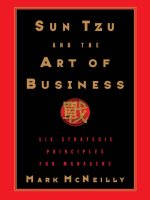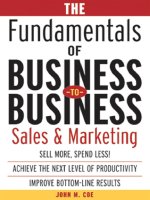The fundamentals of business to business sales and marketing
Bạn đang xem bản rút gọn của tài liệu. Xem và tải ngay bản đầy đủ của tài liệu tại đây (1.34 MB, 258 trang )
THE
Fundamentals
OF
BUSINESS
BUSINESS
Sales Marketing
-TO-
and
This page intentionally left blank.
THE
Fundamentals
OF
BUSINESS
BUSINESS
Sales Marketing
-TO-
and
JOHN M. COE
Copyright © 2004 by John M. Coe. All rights reserved.All rights reserved. Manufactured in the United
States of America. Except as permitted under the United States Copyright Act of 1976, no part of this
publication may be reproduced or distributed in any form or by any means, or stored in a database or
retrieval system, without the prior written permission of the publisher.
0-07-143581-6
The material in this eBook also appears in the print version of this title: 0-07-140879-7.
All trademarks are trademarks of their respective owners. Rather than put a trademark symbol after
every occurrence of a trademarked name, we use names in an editorial fashion only, and to the benefit
of the trademark owner, with no intention of infringement of the trademark. Where such designations
appear in this book, they have been printed with initial caps.
McGraw-Hill eBooks are available at special quantity discounts to use as premiums and sales
promotions, or for use in corporate training programs. For more information, please contact George
Hoare, Special Sales, at or (212) 904-4069.
TERMS OF USE
This is a copyrighted work and The McGraw-Hill Companies, Inc. (“McGraw-Hill”) and its licensors
reserve all rights in and to the work. Use of this work is subject to these terms. Except as permitted
under the Copyright Act of 1976 and the right to store and retrieve one copy of the work, you may not
decompile, disassemble, reverse engineer, reproduce, modify, create derivative works based upon,
transmit, distribute, disseminate, sell, publish or sublicense the work or any part of it without
McGraw-Hill’s prior consent. You may use the work for your own noncommercial and personal use; any
other use of the work is strictly prohibited. Your right to use the work may be terminated if you fail to
comply with these terms.
THE WORK IS PROVIDED “AS IS.” McGRAW-HILL AND ITS LICENSORS MAKE NO GUARANTEES OR
WARRANTIES AS TO THE ACCURACY, ADEQUACY OR COMPLETENESS OF OR RESULTS TO BE OBTAINED
FROM USING THE WORK, INCLUDING ANY INFORMATION THAT CAN BE ACCESSED THROUGH THE WORK
VIA HYPERLINK OR OTHERWISE, AND EXPRESSLY DISCLAIM ANY WARRANTY, EXPRESS OR IMPLIED,
INCLUDING BUT NOT LIMITED TO IMPLIED WARRANTIES OF MERCHANTABILITY OR FITNESS FOR A
PARTICULAR PURPOSE. McGraw-Hill and its licensors do not warrant or guarantee that the functions
contained in the work will meet your requirements or that its operation will be uninterrupted or error
free. Neither McGraw-Hill nor its licensors shall be liable to you or anyone else for any inaccuracy,
error or omission, regardless of cause, in the work or for any damages resulting therefrom. McGrawHill has no responsibility for the content of any information accessed through the work. Under no
circumstances shall McGraw-Hill and/or its licensors be liable for any indirect, incidental, special,
punitive, consequential or similar damages that result from the use of or inability to use the work,
even if any of them has been advised of the possibility of such damages. This limitation of liability
shall apply to any claim or cause whatsoever whether such claim or cause arises in contract, tort or
otherwise.
DOI: 10.1036/0071435816
������������
Want to learn more?
We hope you enjoy this
McGraw-Hill eBook! If
you’d like more information about this book,
its author, or related books and websites,
please click here.
To my wife, Cheri, who always understood when I went to my “cave”
to write this book—I love you!
To my daughter, Michelle, who avoided my thoughts for her to follow
in my footsteps and went on to greater achievements as a Christian,
teacher, wife, and mother of two wonderful children,
Jessica and Megan
To Al Hogan, my “little brother,” who went from being mentored
about life to mentoring me in all matters technical, and growing up to
make any parent proud
This page intentionally left blank.
For more information about this title, click here.
Contents
Preface
xi
1 Why Is It So Tough to Sell Today?
Sales Experience Matters
Customers Don’t Want to See Salespeople Anymore
Communication Clutter Is High and Getting Worse
The Buying Process Is More Complex
Multiple Channels and Choices Are More Available
Summary
2 The New Sales Coverage Model
1
2
4
7
8
12
15
17
The Main Message of This Book
What This Book Is Not About
Sales Productivity Is Job Number One
The Four Customer Life Cycle Phases
Do Not Cover the Market by Size of Customer
Covering Large Accounts with Only a Salesperson
Doesn’t Work Either
The Dark Side of Traditional Sales Coverage
Building the Overall Customer Relationship
Sales Productivity Shoots Up
vii
18
18
19
20
24
25
27
29
30
viii
Contents
The Positives and Negatives of the Three Direct
Marketing Media
What About Other Media?
Customer Relationship Management
So, What Does the New Sales Coverage Model Look Like?
Developing the Proper Blend of Contact Media
Summary
3 The Start: Profiling and Targeting the Market
Profiling: Where Are You Now?
Profiling: The Process
Targeting: Where Should You Go?
Summary
4 Segmentation for Communications
The Critical Role That Segmentation Plays
Segmentation: Three Definitions
Microsegmentation: Definition and Benefits
Microsegmentation Approaches
Summary
5 Redesigning the Inquiry-Generation Process
It Takes Bundles of Time and Money to Create
Brand Awareness
The Crux of the Situation
If an Inquiry Is the Destination, Then Planning Is the Road
Offers Determine Why Most People Respond
Summary
31
38
44
47
49
50
51
52
54
66
68
71
72
72
74
77
92
95
96
98
99
102
112
6 High-Yield Lead Qualification
113
Inquiries Are Not Leads!
My Best “Inquiry” Story
Inquiry Screening
Lead Qualification
Summary
113
115
117
125
130
Contents
7 Sales Conversion
Selling the Sales Group
Distributors, Business Partners, Et Al.
Summary
8 Up-Selling/Cross-Selling and Creating Customer Loyalty
The First Sale Is Just the Start
The Job Is to Get the Second Sale
Up-Selling
Cross-Selling Is Harder Than You Think
Achieving Customer Loyalty in B2B
Summary
9 Campaign Planning and Execution
Direct Marketing Leads the Planning Process
The Four Elements for Direct Marketing Success
The Intersection of the Buying Process and Campaign
Planning
Budgeting
The Campaign and Creative Briefs
Testing
Flowcharting
Setting Up the Back End
Postmortem Campaign Analysis
Summary
10 How to Build Your Company’s Database
Where Are Most Companies Today?
Establishing What Data Should Be in the Database
Sources of Data
Updating the Database
The Value of the Data
Summary
ix
131
131
135
140
141
141
142
143
145
146
150
151
152
153
157
158
161
164
168
171
172
173
175
176
177
183
189
190
191
x
Contents
11 How to Measure the Results That Will Sell Management
193
What and How to Measure: The Measurement Ladder
Developing Feedback Systems That Work
Summary
194
208
209
Resource Directory
Index
211
229
Preface
How did I get here? A Harvard study decades ago tracked college graduates to see how many stayed in their area of study. My memory is that
only about 35 percent did. I’m certainly part of the other 65 percent. Not
only did I not stay with my college major, chemistry, but I also left my first
career in sales to become what—a direct marketer?
Funny thing, most of my colleagues have the same story of meandering career paths. Nobody really started out with the goal of a career in
direct marketing. So what was the turning point for me?
It happened back in 1979 when I was VP of Sales and Marketing for
a company in Chicago. I reported to the president, who had a background
in manufacturing and finance, and who was also a screamer—have you
ever worked for a screamer? No fun, I can assure you. One fall day he
entered my office and began to unload on me, in no uncertain terms, that
my department represented 13.5 percent of the total revenue of the company. As he reached the climax of his visit, his voice was in the high decibel range and his face was turning red. I guess this was the first time he
had calculated this, and even though I had been on the job for less than a
year, he blamed me for this apparent great waste of money. Secretly, I
knew he didn’t really like sales guys anyway and the money we spent on
silly things like customer entertaining.
As he finished and was almost out the door, he turned and shouted
out my key goal for the upcoming fiscal year—“Bring that down to 12.5
xi
Copyright © 2004 by John M. Coe. Click here for terms of use.
xii
Preface
percent and, of course, your sales goal stays the same.” Silence at last
but my head was swimming—how in the hell could I meet the revenue
objective with what amounted to an eight percent cut in the budget? If
I cut money it would mean cutting some of our 110 salespeople, as we
didn’t really spend that much money on marketing. On the other hand,
we had already looked at the sales coverage and were putting in place a
new sales organization and coverage model to improve call rates and sales
efficiency.
The only answer was to do something I didn’t know how to do—
increase overall marketing and sales productivity. Fortunately for me, I
was in Chicago and had heard of a group called the Chicago Association
of Direct Marketing. I had recently gotten an announcement of a meeting featuring Shell Alpert, a well-known consultant who was speaking on
business direct marketing. That sounded good even though I didn’t even
know what that meant. I went, listened, and it changed my life. In fact, I
stumbled over direct marketing.
As a result, we quickly instituted a direct mail and modest telemarketing program that focused on removing the need for sales to make cold
calls. That small change freed up enough time for them to call on customers with higher sales opportunities. And guess what—it worked. We
met the challenge and at the end of the year had reduced the 13.5 percent
to 12.0 percent and met the revenue goal. Along the way, I screamed back
one day and he stopped screaming at me—don’t know if it was because I
screamed back or because we met the sales goal.
As they say, the rest is history, and I’m now writing a book about
something I stumbled across almost twenty-five years ago. Do things come
full circle or what? In those twenty-five years, B2B sales and marketing
methods have seen some changes (who would have thought of the Internet in 1979?), but there are still far too many things that have stayed the
same.
For almost all the clients I have worked with and all the ones I hear
about, improving sales and marketing productivity is clearly job number
one. No longer can we continue with the old methods, as they just aren’t
working and are too costly. That is obvious to all. The bigger issue is
what to do and how to do it? This is what the book is all about, and
for me it started twenty-five years ago. During the intervening years, I
learned a lot and have many experiences to share—many of them are in
this book.
Preface
xiii
Frankly, I’m excited about what lies ahead for B2B sales and marketing. I’ve again changed careers and now want to spread the word, and
therefore have started the Sales and Marketing Institute, a consulting, education, and training firm. I’ll end my career odyssey spreading the word
on how to achieve the dichotomous goals of “sell more” and “spend less.”
I guess the screamer had a point!
This page intentionally left blank.
THE
Fundamentals
OF
BUSINESS
BUSINESS
Sales Marketing
-TO-
and
This page intentionally left blank.
1
Why Is It So Tough
to Sell Today?
The first thing you must know before reading this book is where I’m
coming from—or in more finely tuned words, what’s my perspective? Simply, I’m a salesman! I started my career in the chemical and plastic industry as a sales trainee at B.F. Goodrich Chemical in Cleveland, after
graduating from Miami University of Ohio with a chemistry degree
(another way to say I dropped out of premed). After a year of sales and
product training, I found myself in product management, but I eventually
returned to my salesman goal and joined the Chemical Division of Quaker
Oats as a technical representative covering five states. After several years
of selling and a promotion to district manager, along with several more
years of road warriorship, I landed my first big break—the position of
national sales manager.
Being sales manager at Quaker Oats Chemical was really a dual job.
The first was managing the sales group, which, by the way, included three
district managers who were over age fifty and not very happy to be managed by a thirty-year-old long-haired guy (remember the ’70s). The second responsibility was to act as the national account manager for our
large customers, which included a long list of Fortune 500 companies.
1
Copyright © 2004 by John M. Coe. Click here for terms of use.
2
The Fundamentals of Business-to-Business Sales and Marketing
Several other positions followed in the next several years with smaller
firms, as director of sales and marketing and finally vice president of sales
and marketing. All along the way, I spent most of my time in the field with
our salespeople and customers; I really was a sales guy even though my
title changed.
Sales Experience Matters
In essence, my first fifteen years in business were spent directly in selling
or heavily sales-oriented positions. Why am I telling you this? Not to
impress you but to clearly establish my point of view—that of a salesperson. Most of the books, articles, seminars, and conferences on the subject
approach the functions of marketing and sales from the broader viewpoint of marketing. Yes, in the classic marketing definition (sometimes
called marketing with a capital M) sales is a part of marketing. In the real
world, the sales group almost always dominates marketing within a company and is the power source between the two.
A quick definition of marketing is required at this point. Marketing
involves three groups: product/market management, marketing communications, and sales. At times, customer service is included in the “big M”
definition as well. Typically, product management exists to manage the
product development, pricing, technical support, and so on, of the products and/or services the company offers to the market. My references to
marketing in this book relate to the marketing communication function
and not the product management role. The two must integrate closely for
the company to be successful, but the issues facing product management
are quite different and generally do not deal directly with the development of marketing communications targeted at prospects and customers.
In fact, at IBM the product groups were called “sponsors,” as they had the
responsibility of the group’s profit and loss and therefore the budget. We
in marketing communications had to present plans and programs to these
“sponsors” to obtain our budget dollars. In some companies, the product
managers think they know how to do everything and try to also play the
role of the marketing communications department—usually with poor
results.
Why Is It So Tough to Sell Today?
3
In fact, until the early 1990s the marketing communications group
was typically relegated to developing sales literature, creating and placing
advertising in trade journals, arranging for trade shows, and other such
activities. The responsibility to drive revenue and profit clearly resided
with the sales organization. Yet, I hear intelligent marketing communications individuals pontificating on how the sales group needs to change.
With few exceptions, these same individuals have never really held a field
sales position. Yes, they do sell concepts and ideas internally, but they
have no real in-the-field experience.
What’s a field sales experience like? Well, it’s planning out your week
of calls; phoning for appointments; driving or flying to the account locations; waiting in lobbies; seeing customers and potential ones; following
up on items requested; writing trip reports and recording in your “sales
book” information that you need to remember. Today the sales book may
be ACT on the laptop, but you’ll read more about sales force automation
(a horrible term) later in the book. Then, once this week is over, it’s doing
it again and again—not quite like the movie Groundhog Day but close.
It’s a grind, to be sure, but real salespeople wouldn’t have it any other
way, as there are many benefits to offset the grind. The ones that I valued
the most were the adrenaline rush of closing the deal, the independence
and ability to take action now, plus all the personal relationships and fun
to be had along the way. For anyone who is planning a marketing communication campaign that involves the sales staff, understanding this
“road warrior” life is mandatory to launching requests and designing feedback systems that are directed at field salespeople. The old phrase “You
need to walk a mile in my shoes” has an important and double meaning
when it comes to understanding and working with salespeople.
I could go on, but I think I’ve made the point. So, why is this important? Well, frankly, the days when sales ruled and delivered results are
over. The sales group now needs help, and this book is all about deploying a new sales model that fundamentally alters the “go-to-market” sales
and marketing strategy. This new sales model integrates the functions of
marketing communications and sales in a way not visualized by anyone
before the 1990s. Up until now, much of the academic dialogue dealt with
this “integration” from the viewpoint of the marketing department in the
home office. How do you think customer relationship management, or
4
The Fundamentals of Business-to-Business Sales and Marketing
the now-infamous CRM, was received by sales? Not well, I can assure
you. In B2B this home-office approach to improving the company’s sales
revenue is just wrong. To do it right, we need to start from the perspective of the salesperson. There are millions of salespeople in the United
States, as counted by Sales and Marketing Management magazine. They
carry great responsibility and still manage the primary customer relationship. Any new system that doesn’t start from this viewpoint in B2B is
doomed to fail as somewhere between 55 and 70 percent of CRM implementations have failed. (The Gartner Group reports 55 percent and The
Butler Group reports 70 percent failure.)
Several years ago, I was giving a presentation on the appeal and power
of direct marketing as the technique for companies to retool their sales
coverage models. Someone from the audience said, “John, you got it all
wrong. Sales shouldn’t integrate with direct marketing; marketing needs
to integrate with sales.” I’m only sorry that I can’t give the individual
credit here, as I didn’t get his name, but thanks—you’re right!
So, why is it so much harder to sell today? Well, the old model of how
B2B companies went to market is breaking down. The following sections
explore four major trends causing the breakdown.
Customers Don’t Want to See
Salespeople Anymore
Let’s clarify the foregoing statement, as there are still 11.9 million salespeople in the United States, and I am not implying that they should all be
out of work. A more accurate perspective is that customers don’t want to
see salespeople when either they feel they don’t need to or don’t believe it
will help them in their buying process. That said, when an important
negotiation is required, or a key problem or question arises, a sales contact often is not only desired but sought by the customer. This trend is a
far cry from the ’70s and ’80s, when customers relied primarily on the
salesperson for information and guidance regarding products and services
coupled with the comfort brought by a personal relationship. In conversations these days with companies, both large and small, I almost always
hear someone remark, “Our salespeople can’t get to the key buyers anymore.” What’s happened?
Why Is It So Tough to Sell Today?
5
The Value of a Salesperson to Buyers
Andersen Consulting (now Accenture) used to survey industrial buyers
(not just purchasing people) on the characteristics they most valued in
their suppliers. In 1970 the results of this survey showed that the most
important characteristic buyers valued in companies they did business
with was “a knowledgeable and capable outside salesperson.” Other vendor and/or product attributes that followed in importance included price,
service, and quality. The survey was repeated every ten years, and by 1990
the value of the sales call had fallen to eighth place! In 1990 first place was
“the availability of a capable inside salesperson.” Quite a comedown for
the field sales group. Unfortunately, Accenture did not repeat this survey
in 2000, so the results are not current. Nevertheless, for at least twelve
years the market had been saying, “We really don’t want to see salespeople,” and that was before the advent of the Internet and E-business.
Frankly, until recently, most sales organizations haven’t been listening to
their prospects and customers on this point. Why do you think salespeople are still told to go sit in the lobbies of potential or current customers?
The field salesperson has been gradually seeing this lack of receptiveness. Here’s an example. In 1994 I was asked to help out a friend of one
of my best friends, Bill Kassner. Bill’s friend was having a hard time reentering the office supply business in Cincinnati after a ten-year absence.
Here’s what he had to say: “In 1984, the year I left the office supply business, I could go down the street and make ten calls and see eight office
managers. But today if I make the same ten calls, I can only see one or
two. What happened?” Well, what happened is catalogs, superstores, and
inbound call centers. (This was all before the Internet.) In this industry category, the field salesperson had become “not needed” by the office managers. Other sources of information and buying options were now
available. This made seeing a salesperson more of a waste of time, as it
added no value to the buyer or the transaction. I would imagine that if an
office supply salesperson made a call now on these companies, he or she
might be met with shock by the office manager. On the other hand, at
large companies where contracts are negotiated and complex servicing is
required, a salesperson still has value. In most cases, an inside salesperson
is the primary human contact in the office supply business (combined with
frequent direct mailing, catalogs, and E-mails).
6
The Fundamentals of Business-to-Business Sales and Marketing
Time Is the Saleperson’s Enemy
This issue of time or, I should say, the lack thereof, has also made the
salesperson’s job more difficult. Today no businesspeople feel they have
enough time to do their jobs, and when they’re asked by a salesperson for
an appointment, this “lack of time” causes most of them to defer the
request. In other words, less time on the part of buyers translates to resistance to see salespeople. This resistance is also based on the “Why do we
need to meet?” question heard so often today. “Can we handle this on the
phone?” “Does your website contain the information you want to tell
me?” “Do you have an inside person I can call when I have questions?”
These expressions of resistance combined with the time shortage really
make it tough today for salespeople to persuade buyers to see them on a
regular basis.
Buyers now are far more educated about and comfortable with
non–face-to-face and virtual communications to evaluate product or service solutions before making the buying decision. In fact, several years
ago I interviewed an engineer regarding how he made specification decisions on equipment he was designing. Here’s what he said: “I only do business with companies who have a website containing all the technical
information on their products plus an inside technical sales representative
who can answer my questions when I call. I cannot wait for a salesperson to call me back or visit as by that time I’ve had to make my decision,
since our design time cycles are so short today.”
Three Calls per Day Is Now the Norm
Up until recently, all the surveys done on how many sales calls a salesperson made in a day showed that the average was four. For smaller local
sales territories, the number was higher, and for extended drive/fly territories, of course, it was lower. As a sales manager, I always calculated the
maximum number of sales calls for each salesperson by using 200 to 220
selling days per year multiplied by four calls per day, for a total of between
800 and 880 calls per year per salesperson. This gave me a baseline on
how best to organize territory loads between salespeople, since if there
were too many customers to call on, we would logically not cover the territory properly and lose sales. In 2001 Sales and Marketing Management
Why Is It So Tough to Sell Today?
7
released a study that showed that this decades-old average of four had
shrunk to three—a whopping 25 percent reduction in sales productivity!
I recently visited a large company with 800 salespeople where the calls per
day had decreased to 1.5 from 3.5 in just the last five years. Of course,
the national average and this company’s call rate didn’t drop in one year
but rather was declining over time, all due to the previously mentioned
issues.
Communication Clutter Is High
and Getting Worse
Advertising messages are now coming at us from new and multiple
sources: in restaurant rest rooms (on the backs of stalls and now actually
on the toilet paper), on panels in airport baggage claim belts, on the sides
of cars and buses, in pop-ups on websites, and so on, and so on. Here are
some scary statistics:
• Advertising Age reported in 2000 that the average number of messages we either see or hear daily is now between 4,000 and 5,000.
• This followed a 1999 Intertec report documenting that messages
directed at us had increased sixfold in the last twenty years to 3,000 per
day.
• A 2000 Pitney Bowes study found that in the office we receive 204
messages a day in the United States. Other countries are not far behind:
191 in the United Kingdom, 178 in Germany, and 165 in France.
• In 2001 an estimated 1.4 trillion E-mail messages were sent by businesses—up from 40 billion in 1995. On top of that, in early 2003 nearly
40 percent of all E-mail messages sent were spam, and by the end of the
year, industry experts expect that number to reach 50 percent. Talk
about clutter! How many E-mails do you now get each day at home and
at the office?
This message (pun intended) is clear: we have become an overcommunicated society, and most of us have reached a point of “sensory overload.”
We are just tuning out messages both wanted and unwanted. Studies have









